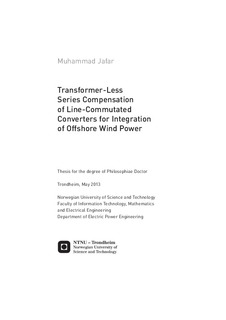| dc.contributor.advisor | Molinas, Marta | nb_NO |
| dc.contributor.author | Jafar, Muhammad | nb_NO |
| dc.date.accessioned | 2014-12-19T13:53:43Z | |
| dc.date.available | 2014-12-19T13:53:43Z | |
| dc.date.created | 2013-04-14 | nb_NO |
| dc.date.issued | 2013 | nb_NO |
| dc.identifier | 616011 | nb_NO |
| dc.identifier.isbn | 978-82-471-4355-1 (printed ver.) | nb_NO |
| dc.identifier.isbn | 978-82-471-4356-8 (electronic ver.) | nb_NO |
| dc.identifier.uri | http://hdl.handle.net/11250/257420 | |
| dc.description.abstract | Wind energy is gradually becoming a major contributor to the overall energy production, especially in the developed world. This is because of the ever- increasing concerns about long-term availability of conventional fuels, global warming, and energy security. Wind power production is gradually moving offshore because of scarcity of onshore sites (particularly in Europe), environmentalists’ concerns over noise and visual pollution, and better wind conditions out in the open sea. Offshore wind farms are generally located close to the shore currently in shallow waters. However, more power demand from wind will eventually put more and more wind farms farther out in the deep sea. This would require floating turbine and grid-integration platforms.
This is where High Voltage Direct Current (HVDC) interconnection between the offshore power plant and the onshore grid would become more attractive than the AC option. The power to be transmitted, if in excess of a certain amount, would necessitate either multiple Voltage Sourced Converter based HVDC (VSC HVDC) links or a single Line Commutated Converter based HVDC (LCC HVDC) link. The latter could be a cheaper option.
LCC HVDC is and will remain the preferred choice for point-to-point transmission of bulk power in the foreseeable future due to it being a proven technology in use for more than half a century, its lower losses, and high power and voltage capability. There remain inherent issues of black-start, high content of lower-order harmonics, and high fundamental-frequency reactive-power consumption. The reactive power and harmonics are traditionally compensated-for by shunt-connected passive filters, which take up a lot of area and make the LCC HVDC terminal size large and expensive. In a deep-sea offshore perspective, this would increase the cost of the floating platform.
This work has explored the possibilities of improvement in transformer-less series compensation of LCC HVDC so as to reduce the size of the converter terminal. The behaviour of the capacitor commutated converter based HVDC (CCC HVDC) was first compared to the conventional system. Later on, the Gate Commutated Series Capacitor (GCSC) was analysed for its potential in the reduction of the converter terminal size.
The work ultimately culminated in the proposal of a new compensator termed the Series Pulsed Voltage Compensator (SPVC), which is a transformer-less series-connected compensator employing full bridges. The compensator reduces the reactive-power consumption of the HVDC terminal in addition to compensating for the reactive-power consumption of the heavy leakage reactances of the converter transformers. It also reduces the lower-order current harmonics. The compensator demonstrates the capability to follow the changes in reactive-power reference at any given active-power flow, a functionality which would eliminate the switching requirements employed in the conventional shunt compensation technique. Experiments on a small-scale laboratory setup have validated the simulation results.
The functionalities mentioned above have been achieved using very small capacitors in the SPVC. This indicates a potentially significant reduction in the need for shunt-connected capacitor banks and large passive-filter inductors with associated switchgear for reactive and harmonic compensation. This would result in a sizeable reduction in the size of the LCC HVDC terminal.
The simulation and modelling of an active shunt-connected reactive/harmonic compensator based on the relatively recent Conservative Power Theory is also presented in the appendix A. In addition, a few suggestions for improving the dynamic behaviour of the HVDC control loops are presented in appendix B. | nb_NO |
| dc.language | eng | nb_NO |
| dc.publisher | Norges teknisk-naturvitenskapelige universitet | nb_NO |
| dc.relation.ispartofseries | Doctoral Theses at NTNU, 1503-8181; 2013:126 | nb_NO |
| dc.title | Transformer-Less Series Compensation of Line-Commutated Converters for Integration of Offshore Wind Power | nb_NO |
| dc.type | Doctoral thesis | nb_NO |
| dc.source.pagenumber | 220 | nb_NO |
| dc.contributor.department | Norges teknisk-naturvitenskapelige universitet, Fakultet for informasjonsteknologi, matematikk og elektroteknikk, Institutt for elkraftteknikk | nb_NO |
| dc.description.degree | PhD i elkraftteknikk | nb_NO |
| dc.description.degree | PhD in Electric Power Engineering | en_GB |
